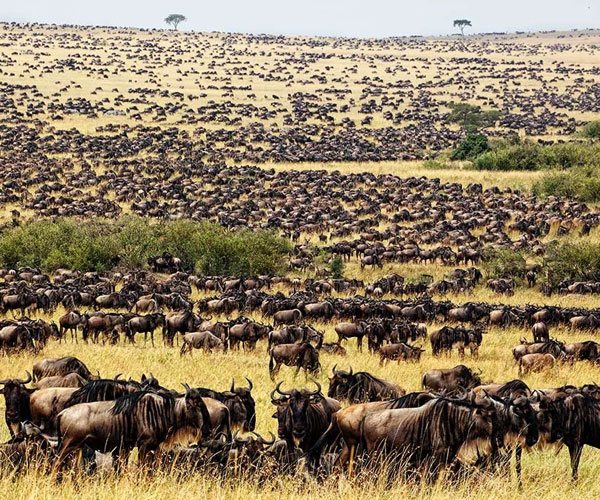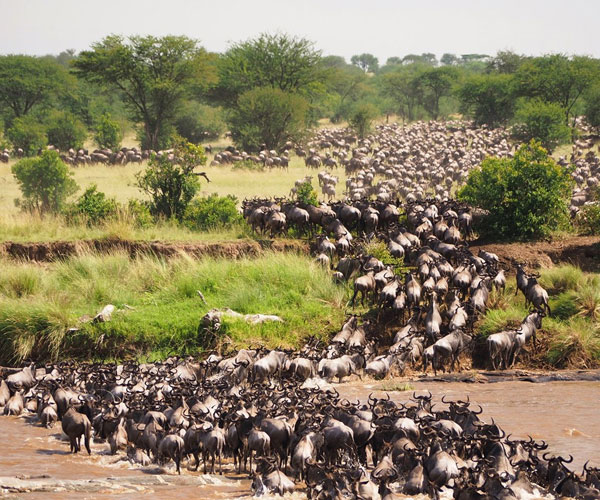Serengeti National Park
Where the magic happens at nature's pace
Find Your ExperienceThe Serengeti comes from the Maa word ‘Serengit’, which translates to ‘the place where the land moves on forever’. Serengeti National Park is the far-reaching, endless savannahs that inspired the Lion King, and is now the most popular Tanzania Safari Destination in the world.
Serengeti National Park is probably the world’s most famous Tanzania National Park. It’s known for its Great Plains and huge population of predators, especially lions. On top of that, Serengeti is home to one of the largest annual animal migrations on our planet; the great wildebeest migration.
Because of this Serengeti has become the safari highlight for many wildlife enthusiasts. The park has grown substantially more popular after appearing several times in nature documentaries like Planet Earth, BBC and many more.
Serengeti National Park lies in the most northern part of Tanzania, bordering Kenya and the Maasai Mara. The park covers a vast area of around 15.000 square kilometers featuring huge savanna’s, mountains, forests and many rivers.
There are three popular regions for safari in the Serengeti: the southern plains, the central Seronera Valley, and the western corridor.
The southern plains are flat, open areas of short grassland. This is the quintessential Serengeti landscape, and what you probably picture in your head when you think of safari.
The central Seronera Valley is a network of river valleys whose rich grazing grounds attract the largest numbers of wildlife in the region. This is the most popular area to visit.
The best time to see the Serengeti Migration is from July to October. This is the dry season, and in June and July the herds will be facing their biggest challenge: the Mara river crossing.
If you are keen on seeing the predators in action, go in January or February, when there is a hiatus in the annual rains and the wildebeest calve.
The average temperature in the park during the year is 25-28 degrees Celsius.
In a nutshell, Serengeti National Park in Tanzania is famous for being the location of the Great Wildlife Migration, which sees two million wildebeests, zebras and antelopes stretched across its plains. It's also an extremely large and wild game park, and is home to the Big Five.
If you are planning a Serengeti National Park Safari, you probably have a ton of questions. Naturally, you want it to be the journey of a lifetime and it will be. Why? There are only few places left with such unspoilt nature splendour, exhilarating wildlife and world-class safari lodges & camps.
Plus, we are here to assist. We would like to provide a bit more background information - if only to stir the anticipation of going on a Serengeti Safari – and answer the questions you might have.
Ready to explore the Serengeti National Park? The Tanzania Safari Packages showcase just some of what is possible. Use these itineraries as starting points, or to draw inspiration. Then get in touch with Pukka Adventure, and let our expert team help craft the perfect itinerary for you.



100% CHANCE

95% CHANCE

100% CHANCE

100% CHANCE

100% CHANCE

100% CHANCE

100% CHANCE

100% CHANCE












January usually marks the start of the short dry season, although the exact timings of this are a little unpredictable. You can expect clear blue skies and sunshine, if the short rains have stopped, and the temperatures will be building. The short dry season is a little less pronounced in Southern Tanzania, and so it can still be wet in these areas. It is an interesting time for avians as resident birds go into breeding plumage and migrant species can be present.
Once the New Year busy period has quietened down, January can offer great value and quieter parks, although the weather can be variable, and in the Selous and Ruaha the wildlife is more dispersed.
February is during the short dry season and is one of the hottest months in Tanzania, with temperatures reaching around 33°Celsius. This can be a good time to visit, as some areas of the Northern Circuit are comparatively quieter than during the European summer months, and lodge rates are also a little lower.
The wildebeest will typically be on the southern plains of the Serengeti for their calving season, which tends to occur in a 2-3 week window in early-mid February – although this does vary year on year. This is also a particularly rewarding time for birdlife, as northern hemisphere migrants join the resident species.
The heavier ‘long rains’ start in earnest in March although exactly when varies year on year. With no need to stay close to permanent water sources, migratory wildlife disperses, and so game viewing starts to become more challenging. This is most prominently seen in Tarangire National Park. The wildebeest migration may still be calving, or have moved on into the central regions of the Serengeti.
Many of the camps in the southern parks close mid March and mobile tented camps in the Serengeti will wind down towards the end of the month in order to move location or carry out refurbishments, ready for the new tourist season.
April is in the middle of the long rainy season and is the wettest month, with on average 250mm of rain. Temperatures are fairly high and humid in comparison to the rest of the year. Expect the bush to be lush and flowering, and alive with insects, birds and smaller animals. It is however also dense, allowing wildlife to hide, which in turn makes game viewing harder. This is a very quiet time in terms of visitor numbers.
Many of the tented camps are closed in April, however the larger lodges remain open. The rates are significantly cheaper, and so if you are willing to work harder to spot the bigger game, some accommodation bargains can be had.
As Tanzania is close to the equator there is no dramatic difference in climate throughout the year, but temperatures do start to drop a little in May. The rains are likely to still be present, although potentially clearing towards the end of the month. Visitor numbers and lodge rates are still low. The wildebeest migration is making its way through the western regions of the Serengeti, crossing the Grumeti River.
Virtually all camps in southern Tanzania remain closed, and many of the roads and tracks in the Selous become impassable.
The rains come to an end at some point during the month and migratory wildlife begins to be drawn back to perennial water sources as the land starts to dry up. It’s likely that the parks will still be quite green and the grass high though, so walking and fly-camping may be unlikely. This marks the start of the season with camps reopening, but prices are still more affordable than the subsequent months.
The migration may still be in the Western Corridor, or on the move northwards towards the Mara River. Western Tanzania presents more challenging conditions for chimpanzee trekking in Mahale National Park, as the chimps are higher in the mountains.
July is considered to be the start of the peak season, with no rainfall expected and pleasant daytime temperatures. As the parks dry, the wildlife congregates in fewer areas, grass is eaten and trampled by the migration, and game viewing gets better and better. The wildebeest are typically arriving in the northern Serengeti, ready to begin their period of crossings of the Mara River.
In the Selous and Ruaha wildlife sightings can be fantastic, with animals gathering around the lakes and rivers. Great conditions and school holidays mean the parks are at their busiest, with Ngorongoro and the Serengeti particularly crowded.
August is the middle of the long dry season, with clear skies and sunny weather. You can expect some cooler weather at night and first thing in the morning. Remember to pack layered clothing, so you can wrap up warm on your early morning game drives, but remain comfortable as it heats up throughout the day.
August is a very popular time to visit, so accommodation prices are at their highest and advanced booking is necessary. It can get noticeably busier in some of the northern parks – in particular the Ngorongoro Crater and northern Serengeti, as visitors flock to the area in hope of witnessing an exciting migration river crossing.
September can be an excellent time of year to visit Tanzania. As the parks continue to dry up the wildlife becomes increasingly reliant on the remaining water sources, leading to high densities of animals. Whilst early September can be busy, with fewer families traveling at this time the parks typically become quieter as the month goes on.
You are still likely to see the wildebeest migration in the northern Serengeti, with river crossings occurring on a regular basis. Tanzania’s southern parks are also fantastic at this time of year, generally receiving far fewer visitors than the north, and wildlife sightings can be great. Prices remain high and the weather generally remains good.
At the tail end of the dry season, the wildlife should be the easiest to spot, although photographers should be aware that it can be a bit dusty at this time of year, as there has been no rain for several months. Great general wildlife viewing throughout as animals are attracted to remaining sources of water. Elephant numbers are particularly high at this time in Tarangire, and Mahale and Katavi are especially rewarding with frequent wildlife sightings close to camp.
There is a chance of rainfall towards the end of the month, if the short rains commence. While prices remain high, visitors numbers are significantly lower than in July-August.
In November you can expect the start of the short rains, although the start date varies every year. The rains are highly localised, and are much lighter and more unpredictable than the long rains that occur earlier in the year. These should not really interfere with your safari – as the game viewing at this time is still good - but you should pack a waterproof jacket and be prepared for some short rain showers!
The majority of tented camps remain open, but some of the mobile camps in Northern Tanzania will close for the latter half on the month. Given the seasonality, camps are charging shoulder season rates so there are often some bargains to be had. Early November can offer great value for money and the weather conditions are likely to be comparable to late October.
December is also during the short rainy period, but this does not stop Tanzania being a popular destination to spend the festive period. Be aware that many of the lodges book up early, and charge peak rates over this time. Advanced booking is essential over this period, especially if travelling in larger family groups.
Travelling in December outside of the festive period allows travellers to make use of excellent shoulder season rates. Temperatures are pleasant with the averages of 27Celsius, although there is the chance of intermittent thunderstorms.